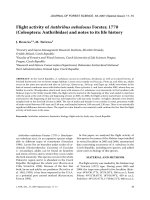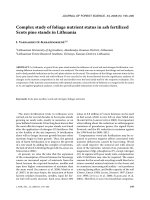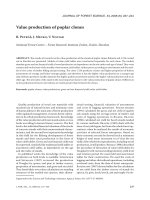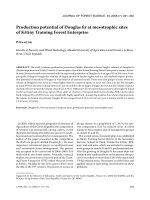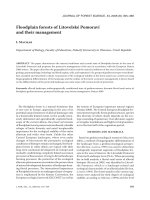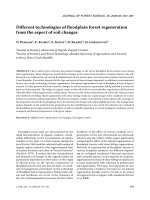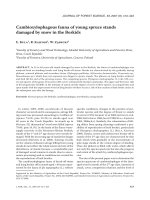Báo cáo lâm nghiệp: "Frost resistance of seeds in Mediterranean oaks and the role of litter in the thermal protection of acorns" docx
Bạn đang xem bản rút gọn của tài liệu. Xem và tải ngay bản đầy đủ của tài liệu tại đây (608.33 KB, 6 trang )
481
Ann. For. Sci. 61 (2004) 481–486
© INRA, EDP Sciences, 2004
DOI: 10.1051/forest:2004042
Original article
Frost resistance of seeds in Mediterranean oaks and the role of litter
in the thermal protection of acorns
Jordán ESTESO-MARTÍNEZ, Eustaquio GIL-PELEGRÍN*
Centro de Investigación y Tecnología Agroalimentaria de Aragón, Gobierno de Aragón, Aptdo 727, 50080 Zaragoza, Spain
(Received 19 March 2003; accepted 26 June 2003)
Abstract – The endogenous frost resistance of the seeds of four Mediterranean oaks (Quercus coccifera, Q. faginea, Q. ilex and Q. pyrenaica)
with different leaf abscission phenology was tested. Thermal analysis and polyelectrolytes leakage methodologies were employed to establish
lethal temperature thresholds. Results showed a higher frost resistance for evergreen species and lower for deciduous species in this decreasing
order: Q. coccifera, Q. ilex, Q. faginea and Q. pyrenaica. The cover of leaf litter generated by deciduous species could be an isolating element
which allowed seed survival under cold winter conditions to that species with a lower frost resistance. Differences in temperature above and
below a leaf litter cover along a winter season were measured in a Q. faginea stand, in this sense the kind effect of leaf litter from a thermal
point of view was proved.
frost resistance / leaf litter / polyelectrolytic leakage / Quercus / thermal analysis
Résumé – Résistance au froid des semences de chênes méditerranéens et rôle de la litière comme protecteur thermique des glands. On
a testé la résistance intrinsèque à la gelée dans les semences de quatre espèces de chênes méditerranéens (Quercus coccifera, Q. faginea, Q. ilex
et Q. pyrenaica) différents par la phénologie de l’abscission foliaire. Des méthodes d’analyse thermique et des mesures de fuite de polyélectrolytes
ont été utilisées pour établir les températures létales. Les résultats montrent une meilleure résistance des espèces à feuilles persistantes dans
l’ordre suivant (Q. coccifera, Q. ilex, Q. faginea, Q. pyrenaica). La litière produite par les espèces à feuilles caduques en tant que possible
protecteur thermique permettrait la survie des glands ayant une résistance intrinsèque insuffissante vis-à-vis des températures hivernales de la
région. De plus, on a mesuré les différences de température en-dessous et dessous la litière pendant une période hivernale dans une forêt de
Q. faginea. L’effet de la litière en tant que protecteur thermique a été confirmé.
analyse thermique / fuite de polyelectrolytes / litière / Quercus / résistance au froid
1. INTRODUCTION
Mediterranean climate is usually characterized by dry and
warm summers and wet and mild winters [16, 17]. However it
shows regional variations which differ from this general pattern
when considering their rainfall and temperature regimes [33,
41]. Broad inner areas of Iberian Peninsule present a continen-
tal variant of Mediterranean climate with dry and cold winters
[21, 22]. This winter conditions have been considered as critical
periods for plant life [17, 33]. Some authors have even sug-
gested that winter frosts could limit the geographical distribu-
tion of some Mediterranean oaks [15] operating negatively on
some critical aspects of the physiology of seedlings [29, 35].
Less amount of information is available about the conse-
quences of exposure to below zero temperature of oak seeds in
natural conditions, although it is generally accepted that freezing
processes are a constraint for regeneration [3, 5, 6, 13, 42, 43].
Available data about frost resistance of acorns are mostly rela-
ted with long-term seed conservation. These studies focus on
maximizing frost resistance of seeds at the expense of a reduc-
tion of their water content with no apparent losses in their via-
bility [9, 14, 23, 24]. Ecological implications of these studies
do not appear clearly since their experimental conditions are
quite different from natural ones, however they show that
acorns die at temperatures which are not exceptional during
mediterranean winters in continental areas of the Iberian Penin-
sule [22]. In this way Boese et al. [9] fix a threshold for Quercus
velutina around –7 ºC, other authors found for other species
values around –10 ºC [11, 14, 23, 24].
It may be wondered now if thermal stress evitation mechanisms
(supercooling) of seeds of certain mediterranean oak species
are capable of guaranteeing the survival to winter conditions
in their most continental areas of distribution. When certain tem-
perature thresholds may be exceeded, the presence of a buffering
* Corresponding author:
482 J. Esteso-Martínez, E. Gil-Pelegrín
element which gave enough thermal insulation would be criti-
cal for the regeneration of these species. In areas where some
other isolating elements such as a snow cover [6, 27, 40, 45]
are not common or show a short persistance [22] leaf litter may
be supposed to be the main way of avoiding freeze stress due
to its remarkable insulation capability [19].
The characteristic leaf phenology (semideciduous) of some
oak species from mediterranean areas [1, 18] could ensure the
presence of a leaf litter cover above the seeds that would
improve their thermal microhabitat [26, 31]. This improvement
may not be so obvious for evergreen species which should be
able to overcome winter frosts depending on other factors. In
this way it is likely to believe that evergreen species produced
seeds with a higher frost resistance.
The aims of this study are the comparison of lethal temper-
atures for seeds of mediterranean oak species with different leaf
phenology (evergreen and semideciduous) so as the establish-
ment of a relationship between this frost resistance and their
ability to create a leaf litter cover which protected acorns during
winter. The insulating role of leaf litter along a winter season
in a Q. faginea stand in the Zaragoza province was monitored
to check its insulation capability.
2. MATERIALS AND METHODS
2.1. Plant material
Seeds of Q. coccifera, Q. faginea and Q. ilex were collected during
autumn of 1999 at several locations of Zaragoza province (Q. coccif-
era at Ejea de los Caballeros, Q. faginea at Daroca and Q. ilex at Paniza,
Aladrén and Alfamén, these last three locations in a few kilometres
range) except for Q. pyrenaica which were obtained from collections
made by National Center of Forest Improvement “El Serranillo” (Min-
isterio de Medio Ambiente) at Serrania de Cuenca (Cuenca province).
Seeds were selected and rehydrated by the floating method in tap water
for 24 h. Afterwards they were disinfected by inmersion in a 5%
sodium hypochloride (40 g/L of active chlorine) solution for 10 min
and then carefully rinsed in tap water. Finally, seeds were stratified
and treated with a common use fungicide (Pomarsol a.p Thiuram,
Bayer) and then kept in a cold-storage room at 2 °C until the experi-
ment started.
2.2. Thermal analysis
Temperature profiles were made in a modified commercial freezer,
establishing cooling rates through an industrial controller (PMA Pro-
zess-und Maschinen-Automation GmbH Mod. KS90, Germany) act-
ing on a heating block with forced convection. Freezing was provided
by the continuous performance of the freezer engine. Thermal homo-
geneity was achieved through a microfan system arranged inside of
the chamber. This device provided a thermal stability of ± 0.1 ºC on
set temperature along the whole thermal profile.
Methodology for thermal analysis was inspired by the one used by
Boese [10]. However some modifications were necessary according
to different recording methods and different theoretical approach. In
our study we performed a thermal analysis instead of a differential
thermal analysis and for temperature measurements two-wires PT100
sensors were used instead of thermistors. These modifications were
necessary due to the features of the eight-channels digital recorders
(A.B.I. Data Mod. VL100, Belgium) used in the experiment. In addi-
tion, no external ice nucleation source was used in any case.
Seeds used in the thermal analysis experiment were directly
extracted from the cold-storage room, dried with a cloth and immedi-
ately set for the experiment. Moisture content was estimated previ-
ously to the experiment in 10 units batches of each species following
the methodology suggested by Thomsen [48]. Very similar moisture
contents were obtained for the four species (46% ± 2 SD, n =10per
species).
The PT100 sensor was firmly attached to the seed pericarp with
adhesive tape and the whole wrapped in a piece of aluminium foil.
Seeds were set in 10 units batches on a polyestirene platter inside of
the freezer. Five reference wrapped sensors were set between each two
seeds. Finally a bare sensor was set next to the samples to record cham-
ber temperature. No external ice nucleation source was used in order
to allow supercooling. The fixed cooling rate was of 1.5 ºC/h. This
cooling rate reasonably matches with the ones recorded by us in the
field (unpublished data) so as with the ones found in the literature [3,
10, 12, 14].
2.3. Field temperature
Temperatures in the field were recorded along six weeks (during
January and February) above and below a leaf litter cover in four dif-
ferent points with homogeneous leaf litter thickness. Four fixing
devices suitable for measurement at two different heights (above and
below leaf litter) were designed. This devices consisted of a steel axis
with a white lacquered aluminium dish at the top acting as a solar-
shield and two PT100 sensors attached at two different heights. The
whole were fixed on the ground reconstructing as possible leaf litter
structure after setting.
Average leaf litter thickness was estimated at 6 cm at the beginning
of measurements. Natural leaf litter compression was allowed along
recording period and upper sensor height was readjusted.
Sensors were connected to an eight-channels digital data recorder
(A.B.I. Data Mod. VL100, Belgium) placed in a waterproof case and
provided with a 30 days proved duration battery. With the aim of estab-
lishing correlations between our field measurements and a nearby
weather station (Daroca 1° 25’ W, 41° 07’ N, 779m a.s.l.) a third one-
channel digital data recorder (Gemini Data Loggers Mod. Tinytalk II,
London UK) provided with a PT100 sensor covered with a solar-shield
was set at 1.5 m height above ground next to the other measurement
points.
2.4. Polyelectrolytic leakage
The polyelectrolytic leakage analysis was planned with the aim of
establishing a correspondence between ice formation inside the seed
and tissue injury [10]. In this sense it was possible to attribute lethal
consequences to ice formation.
In this experiment it was employed the same freezer as in the ther-
mal analysis. Temperature profiles were adapted to experimental
needs. This way, once established ice formation temperatures for the
different species (from results of thermal analysis), five cooling-heat-
ing cycles (from 0 ºC to –3, –6, –9, –12 and –15 ºC respectively) were
performed at the same cooling rate (1.5 ºC/h) for each species. Six
seeds were used simultaneously in each cooling-heating process.
When cooling and heating process concluded, seeds were taken out
from the chamber and immediately prepared for the experiment. A cot-
yledon section (width 2 mm) of each seed was obtained using a two
parallel scalpel blades assembly. The sample was gently rinsed in dis-
tilled water and sunk in 5 cm
3
of distilled water in a glass tube. Full
tubes were weighted in order to compensate subsequent evaporative
water losses before the measurements. Tubes were sealed with Parafilm
and samples were left at room temperature for 24 h. A first measure-
ment was performed to record the conductance of the polyelectrolytic
leachate of the samples.
Frost resistance and leaf litter in Quercus acorns 483
After measurements samples were boiled for 10 min to achieve a
total tissue degradation and left cool at room temperature for 2 h. The
conductance of boiled samples were registered after this period. Water
losses were systematically compensated before each measurement.
Equations for determining tissue injury rest on the ones proposed by
Flint et al. [20]. As a basal leakage value it was employed a mean value
(n = 15 per species) of undamaged samples of each species with the
same characteristics as the ones used in the experiment.
A conductimeter (Conductimeter Basic 30, Crison Instruments
S.A., Spain) was used for all the measurements. As a reference, an Lt50
value (temperature at which 50% of injury is reached) was obtained
according to the sigmoid model obtained for each species.
3. RESULTS
3.1. Frost resistance
The thermal analysis performed on the seeds of the four stu-
died species allowed to establish significant differences among
them. Average freezing temperatures for the four species are
shown in Figure 1. As a reference it has been considered the
starting point of the exotherms as suggested in several studies
[10, 12]. Some freezing and exotherm profiles are shown in
Figure 2.
It is remarkable the presence of an apparent high temperature
exotherm a few degrees below zero, only in the deciduous species
(Q. pyrenaica and Q. faginea). This fact may be similar to the
one observed in other studies and it is attributable to some kind
of extracellular freezing process.
All these results are consistent with the polyelectrolytes lea-
kage analysis where Lt50 values arrange species in a very simi-
lar way, as shown in Figure 3.
3.2. Long term climatic characterization
Taking into account the available data from Daroca (Zara-
goza) weather station which comprise the period from 1919 to
2000 (except for the period 1930–1942) it has been possible to
establish a minimum temperatures probability distribution.
Considered data are referred to the days between winter solstice
and spring equinox. Probability distribution is shown in Figure 4.
Considering frost resistance values for other Quercus species
acorns found in other papers [9–11, 14, 23, 24] so as the ones
recorded by us, it can be observed that minimum temperatures
Figure 2. Typical freezing and exotherm profiles for the four species studied (in increasing order of frost resistance). Exotherms represented
are obtained from mean values of starting point, width and duration of data obtained in thermal analysis. Time represents hours since experi-
ment started. Cooling rate was 1.5 ºC/h.
Figure 1. Average freezing temperature (starting point of exotherm)
for the four Quercus species studied. Vertical bars represent SE of the
mean (n = 10 per species).
484 J. Esteso-Martínez, E. Gil-Pelegrín
in our study area could exceed the resistance threshold of the
seeds with relative frequency. Anyway since the exposure of
the seeds to lethal temperatures is a critical process [9], even a
low frequency of this phenomenon could be a limiting factor
to seed survival.
Data recorded to establish the differences in temperature due
to the presence of a leaf litter cover could register some of those
critical periods. It is shown the efficiency of this cover as a ther-
mal insulating material, maintaining minimum temperatures in
a non lethal level even when –13.3 ºC were registered a few
centimetres above. This is shown in Table I.
4. DISCUSSION
Once again it has been possible to check the deviations from
the typical conception of mediterranean climate that appear in
the most continental areas of its influence. Night frost periods
are in this way usual phenomena in these areas during winter.
Minimum temperatures reached occasionally during these
periods could be a limiting factor for seed reproduction of some
species with specially sensitive seeds such as Quercus species
[9, 42–44].
Acorn survival after exposure to below zero temperatures
has been tested in several previous papers. However, under
extremely cold winters such as the ones found in continental
areas of mediterranean climate, the range of frost resistances
shown in those studies suggests the unfitness of endogenous
mechanisms of stress evitation to overcome winter seasons in
these areas. Our results confirm frost resistances that are con-
sistent with previous studies. In this way, low temperatures
could endanger seed regeneration for the studied species in our
study area under present climatic conditions.
It is remarkable the arrangement of the threshold values of
frost resistance obtained in both the thermal analysis and poly-
electrolyte leakage (Figs. 2 and 3). It can be observed that seeds
of evergreen species (Q. coccifera and Q. ilex) appear to be
more resistant to freeze stress. This is consistent with the most
continental description of these species [2, 4].
Table I. Absolute minimum, maximum and mean temperatures measured below and above a leaf litter cover in a Quercus faginea stand in the
Zaragoza province (Spain).
Week
Under leaf litter Over leaf litter
Absolute minimum
°C
Absolute maximum
°C
Mean
°C
Absolute minimum
°C
Absolute maximum
°C
Mean
°C
1 –3.50 3.50 –0.70 –13.30 16.45 –3.17
2 –3.85 5.00 –0.88 –13.30 21.30 –2.05
3 –1.30 9.80 3.10 –9.80 23.10 3.38
4 0.35 10.85 4.66 –6.65 25.20 4.84
5 –0.70 12.25 4.21 –9.45 28.00 4.02
6 –0.70 12.25 4.73 –8.75 26.25 4.55
Mean –1.62 8.94 2.52 –10.21 23.38 1.93
Figure 3. Mean index of injury obtained from polyelectrolitic lea-
kage measurements at different temperatures for the four species stu-
died. Vertical bars represent SE of the means (n = 6 per temperature).
Dotted lines represent Lt50 values at the cutting point with sigmoids.
Figure 4. Probability distribution of minimum temperatures measured
at Daroca weather station during the period from 1919 to 2000 (except
for the period 1930–1942). Data are referred to the days between win-
ter solstice and spring equinox.
Frost resistance and leaf litter in Quercus acorns 485
The role of leaf litter as an insulating material appears now
as an important element in improving the microhabitat of seeds.
This has been reported frequently in several papers [7, 25, 30–
32, 34, 43, 46] considering factors such as light, relative humi-
dity, nutrient recycling, predation and temperature. However
some other studies attribute to leaf litter negative effects that
should not be obviated such as all allelopathic phenomena,
pathogen proliferation or rooting difficulties between others [8,
19, 28, 37, 47]. Nevertheless some features of seeds and leaf
litter of Quercus could balance partially these undesirable
effects. In this way, Kostel-Hughes et al. [26] concluded that
determined species with large seeds (Carya cordiformis, Quercus
rubra and Quercus alba) perform indifferently or are even
favoured by a thick cover of leaf litter. Lopez-Barrera and
Gonzalez-Espinosa [30] observed that acorns fallen over oak
leaf litter were progressively displacing downwards being
finally covered by one o several layers of leaf litter. This pheno-
menon was not observed if acorns fell over a pine needle cover.
The main objective of this paper is to emphasize the key role
of leaf litter in the survival of frost sensitive seeds such as Quercus
acorns. Since endogenous frost resistance mechanisms of the
acorns of the deciduous result inadequate to overcome winter
conditions in continental areas under Mediterranean climate, it
is possible to us to suggest that leaf litter not only creates a better
regeneration conditions but the only way of avoiding freeze stress
for the deciduous species studied. Endogenous frost resistance
of evergreen species studied may be also exceeded in occa-
sions. The phenology of abscission of some evergreen species
has been studied resulting in a progressive loss of leaves along
the year [18] or an early abscission in relation to seed dispersal
[38, 39]. In this way the litter covering effect achieved by ever-
green species may be weakened in addition since leaf litter
redistribution phenomena [36] could act extensively until acorn
shedding. These results suggest the benefits of the generation
and conservation of mixed stands of deciduous and evergreen oaks
to encourage seedling recruitment under continental conditions.
Acknowledgements: This work was partially supported by a post-
graduate INIA (Instituto Nacional de Investigación y Tecnología
Agraria y Alimentaria) grant to the first author.
REFERENCES
[1] Abadía A., Gil E., Morales F., Montañés L., Montserrat G., Abadía J.,
Marcescence and senescence in a submediterranean oak (Quercus
subpyrenaica E.H. del Villar). Photosynthetic characteristics and
nutrient composition, Plant Cell Environ. 19 (1996) 685–694.
[2] Allué-Andrade J.L., Atlas fitoclimático de España. Taxonomías.
MAPA, INIA, Colección Monografías INIA, 69, Madrid, 1990.
[3] Aizen M.A., Woodcock H., Effects of acorn size on seedling survi-
val and growth in Quercus rubra following simulating spring
freeze, Can. J. Bot. 74 (1996) 308–314.
[4] Amaral-Franco J., Quercus L., in: Servicio de Publicaciones del
CSIC, Flora Ibérica, Vol. 2, Madrid, 1990.
[5] Aussenac G., Étude des gelées tardives en relation avec les problè-
mes de reboisement, Ann. Sci. For. 30 (1973) 141–155.
[6] Aussenac G., Étude des relations climat – régénération naturelle de
chêne dans la région de Nancy de 1865 à 1972, Rev. For. Fr. XXVII
(1975) 37–39.
[7] Barrett L.I., Influence of leaf litter on the germination and early sur-
vival of chestnut oak, Quercus montana Willd., Ecology 3 (1931)
476–484.
[8] Beatty S.W., Sholes O.D.V., Leaf litter effect on plant species com-
position of deciduous forest treefall pits, Can. J. For. Res. 18 (1988)
553–559.
[9] Boese S.R., George M.F., Mitchell R.J., Martin U., McQuilkin
R.A., Physical aspects of freezing in black oak acorns, Proceedings
of the Fifth Central Hardwood Forest Conference, Urbana-Cham-
paign, Illinois, USA-April 15–17, 1985, pp. 222–227.
[10] Boese S.R., Physical aspects of freezing in black oak acorns and
selected pine seeds, Thesis, University of Missouri-Columbia,
1986.
[11] Bonner F.T., Storing red oak acorns, Tree Pl. Notes 24 (1973) 12–13.
[12] Boorse G.C., Bosma T.L., Meyer A.C., Ewers F.W., Davis S.D.,
Comparative methods of estimating freezing temperatures and free-
zing injury in leaves of chaparral shrubs, Int. J. Plant Sci. 159
(1998) 513–521.
[13] Burke M.J., Gusta L.V., Quamme H.A., Weiser C.J., Li P.H., Freezing
and injury in plants, Ann. Rev. Plant Physiol. 27 (1976) 507–528
[14] Chmielarz P., Odpornosc mrozowa zoledzi debu szypulkowego
(Quercus robur L.) o wilgotnosci 42%, Sylwan 8 (1996) 33–41.
[15] Cochard H., Tyree M.T., Xylem disfunction in Quercus vessel
sizes, tyloses, cavitation and seasonal changes in embolism, Tree
Physiol. 6 (1990) 393–407.
[16] DiCastri F., Mooney H.A., Mediterranean type ecosystems. Origins
and structure, Springer-Verlag, Berlin, 1973.
[17] DiCastri F., Mediterranean-type shrublands of the world in: DiCastri
F., Goodall D.W., Specht R.L. (Eds.), Mediterranean-type shru-
blands, Elsevier, Amsterdam, 1981, pp. 1–52.
[18] Escudero A., DelArco J.M., Ecological significance of the pheno-
logy of leaf abscission, Oikos 49 (1987) 11–14.
[19] Facelli J.M., Pickett S.T.A., Plant litter: Its dynamics and effects on
plant community structure, Bot. Rev. 57 (1991) 1–32.
[20] Flint HL., Boyce B.R., Beattie D.J., Index of injury – A useful
expression of freezing injury to plant tissues as determined by the
electrolytic method, Can. J. Plant Sci. 47 (1967) 229–230.
[21] Font-Tullot I., Climatología de España y Portugal, INM, Madrid,
1983.
[22] Font-Tullot I., Historia del clima en España, INM, Madrid, 1988.
[23] Guthke J., Langzeitlagerung von Eichensaatgut. Probleme und Moe-
glichkeiten, Thesis, Hannover Universitat, 1993.
[24] Guthke J., Spethmann W., Physiological and pathological aspects
of long-term storage of acorns, Ann. Sci. For. 50 (Suppl. 1) (1993)
384s–387s.
[25] Jones E.W., Biological flora of the British Isles: Quercus L., J. Ecol.
47 (1959) 169–222.
[26] Kostel-Hughes F., Young T.P., Carreiro M.M., Forest leaf litter
quantity and seedling occurrence along an urban-rural gradient,
Urban Ecosystems 2 (1998) 263–278.
[27] Larcher W., Physiological plant ecology, Springer-Verlag, New
York, 1995.
[28] Li J., Romane F., Holm oak (Quercus ilex L.) coppice dynamics in
southern France: The germination stage, in: Song Y., Dierschke H.,
Wang X. (Eds.), Applied vegetation ecology, East China Normal
University Press, Shangai, China, 1994, pp. 122–127.
[29] LoGullo M.A., Salleo S., Different vulnerabilities of Quercus ilex
L. to freeze and summer drought-induced xilem embolism: an eco-
logical interpretation, Plant Cell Environ. 16 (1993) 511–519.
[30] López-Barrera F., González-Espinosa M., Influence of litter on
emergence and early growth of Quercus rugosa: a laboratory study,
New For. 21 (2001) 59–70.
[31] MacKinney A.L., Effects of forest litter on soil temperature and soil
freezing in autumn and winter, Ecology 10 (1929) 313–321.
[32] Merino O., Martín-Vicente A., Producción de hojarasca en dos for-
maciones del SW Español, Lagascalia 15 (extra) (1988) 535–540.
486 J. Esteso-Martínez, E. Gil-Pelegrín
[33] Mitrakos K., A theory for Mediterranean plant life, Acta Oecol. 1
(1980) 245–252.
[34] Molofsky J., Augspurger C.K., The effect of leaf litter on early seed-
ling establishment in a tropical forest, Ecology 73 (1992) 68–77.
[35] Nardini A., Salleo S., Lo Gullo M.A., Pitt F., Different responses to
drought and freeze stress of Quercus ilex L., growing along a lati-
tudinal gradient, Plant Ecol. 148 (2000) 139–147.
[36] Orndorff K.A., Lang G.E., Leaf litter redistribution in a West Vir-
ginia hardwood forest, J. Ecol. 69 (1981) 225–235.
[37] Peterson C.J., Facelli J.M., Contrasting germination and seedling
growth of Betula alleghaniensis and Rhus typhina subjected to
various amounts and types of plant litter, Am. J. Bot. 79 (1992)
1209–1216.
[38] Pérez LaTorre A.V., Cabezudo B., Use of monocharacteristic growth
forms and phenological phases to describe and differentiate plant
communities in Mediterranean-type ecosystems, Plant Ecol. 161
(2002) 231–249.
[39] Pérez LaTorre A.V., Cabezudo B., Nieto-Caldera J.M., Navarro T.,
Caracterización fenológica y ecomorfológica de alcornocales
andaluces (Málaga, España), Anales Jard. Bot. Madrid 54 (1996)
554–560.
[40] Rixen C., Stoeckli V., Huovinen C., Huovinen K., The phenology
of four subalpine herbs in relation to snow cover characteristics, in:
IAHS publ., Soil-Vegetation-Atmosphere transfer schemes and
large-scale hydrological models, IAHS publ. 270 (2001) 359–362.
[41] Rodó X., Comín F., Fluctuaciones del clima mediterráneo. Conexiones
globales y consecuencias regionales, in: Zamora R., Pugnaire F.I.
(Eds.), Ecosistemas Mediterráneos, analisis funcional, CSIC, Madrid,
Spain, 2001, pp. 1–35.
[42] Sakai A., Larcher W., Frost survival of plants. Responses and adap-
tation to freezing stress, SpringerVerlag, New York (1987).
[43] Shaw M.W., Factors affecting the natural regeneration of sessile
oak (Quercus petraea) in North Wales. I and II, J. Ecol. 56 (1968)
565–583, 647–660.
[44] Stanwood P.C., Bass L.N., Ultracold preservation of seed germ-
plasm, in: Li P.H., Sakai A. (Eds.), Plant cold hardiness and free-
zing stress: Mechanisms and crop implications, Vol. 1, Academic
Press, New York, 1978.
[45] Stoeckli V., Rixen C., Characteristics of artificial snow and its
effects on vegetation, in: Conf. Proceedings of the Int. Snow Science
Workshop, Big Sky, Montana, USA, October 1–6, 2000.
[46] Sydes C., Grime J.P., Effects of tree leaf litter on herbaceous vege-
tation in deciduous woodland. I and II, J. Ecol 69 (1991) 237–248,
249–262.
[47] Tao D.L., Xu Z.B., Li X., Effect of litter layer on natural regenera-
tion of companion tree species in the Korean pine forest, Environ.
Exp. Bot. 27 (1987) 53–65.
[48] Thomsen K., Handling of desiccation and temperature sensitive
tree seeds. DFSC Series of Technical Notes. TN56, Danida Forest
Seed Centre, Humlebaek, Denmark, 2000.
To access this journal online:
www.edpsciences.org
